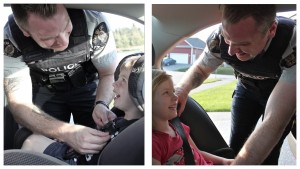In support of Child Passenger Safety Week 2017 (September 17-22), Nova Scotia RCMP is reminding motorists to secure child passengers into vehicles by correctly using the proper car seat, booster seat, and seat belts.
“Child Passenger Safety Week is an annual initiative dedicated to protecting children in vehicles,” says Cst. Chad Morrison, Nova Scotia RCMP Traffic Services. “Motor vehicle crashes are a leading cause of death and serious injury for children in Canada. Using the right seat car or booster seat significantly reduces that risk.”
Some of the most common car seat and booster seat mistakes fall into three categories: choosing the right seat, installing it correctly and properly securing the harness.
Choose the right seat for your child’s age, weight and height
· Babies must ride in a rear-facing car seat until they are a minimum of 22 pounds (10 kg) and until they are at least one year old.
· Children between 22 pounds (10 kg) and 40 pounds (18 kg) must continue to ride in a car seat with a five-point harness. They are safest riding rear-facing until they outgrow the height and weight limits of the seat.
· Children must be a minimum of 40 pounds (18 kg) in order to ride in a booster seat, and should have the maturity to sit correctly. Theymust remain in a booster seat until they are a minimum of 4-foot-9-inches (145 cm), a minimum of 9 years old, and the seat belt fits correctly.
Install the seat correctly
· Tightly secure the seat to the vehicle. It should move less than one inch where attached.
· Always use the top tether strap with a forward-facing seat.
Properly secure the harness
· Secure the harness tight enough that you are unable to pinch the straps at the shoulder.
· Position the chest clip at armpit level, and position the straps in the slot that is level with or below your child’s shoulders when rear facing, and with or above your child’s shoulders when forward facing.
“Families want to know how they can best protect their children,” says Katherine Hutka, Health Promotion Specialist for IWK’s Child Safety Link. “We know that by properly buckling children into the right seat for their age and size, we can reduce the risk of death and serious injury by up to 70 per cent.”
If you have questions about child seats or booster seats, or need clarification on how or when you must use them, visit IWK’s Child Safety Link(http://childsafetylink.ca/child-passenger-safety/).
.
Source: Media Release




